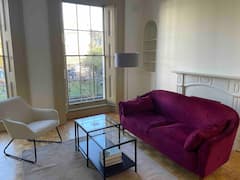An unusual Bedouin tent shaped mausoleum contains the remains of the intrepid Captain Sir Richard Burton and his wife Isabel. The tomb lies in the small district of Mortlake, just 4 minutes by train from the wealthy area of Richmond, a suburb in southwest London.
Who was Sir Richard Burton

Richard Francis Burton (1821-1890) was a British explorer and also a geographer, translator, writer, soldier, spy, cartographer, poet and diplomat. His life and his career was not a simple linear path but rather a zigzag of activities, places, meetings and adventures. His wife Isabel, an aristocratic Catholic, was so devoted to her husband to build a tent shaped tomb for his death, following his last desire of ‘laying side by side in a tent’. Conforming to the design of an accommodation in which they had slept in the Syrian desert, Isabel found a place in the unusual mausoleum in 1896, when she reunited with her husband who had died a few years earlier. Richard Burton was a very controversial figure in the period in which he lived, due to his unbridled interest for different cultures, his criticism against colonialism and all forms of racism, and also for his strong inclination to explore and disseminate knowledge on subjects that were considered taboo at the time. He was fluent in 25 languages and published about 40 books in addition to a translation of the ‘Kama Sutra’ and the ‘Arabian Nights’. He was awarded a knighthood in 1886.
The mausoleum in Mortlake

It takes just a short walk to reach St Mary Magdalen Church after arriving in Mortlake by train from Richmond. The back of the church is quite hidden; a small side entrance takes you to the cemetery. An alley meanders between the grass and heavy stone crosses. From a distance you glimpse something unusual, a sort of house with a sloping roof, a gold star on top and a crucifix a little lower. Getting closer to the house, it takes the form of a tent. The mausoleum, a 3.6 x 3.3 m block of York stone, possesses both a strong Muslim and Catholic symbolism, overcoming the perennial ideological conflict between the two religions. A contrast may also be found in the idea of impermanence and permanence that such an odd object highlights. A tent in the desert and the eternal sleep of death may represent the two temporary and permanent human conditions.
A treasure of memories inside

The wave-like movement of the stone that simulates a curtain blown by the wind, and the fake ropes at the corners, emphasize the three white plaques placed on a hypothetical entrance door to the tent. One of them is a sonnet written by Irish writer Justin Huntly McCarthy, which says: ‘Farewell, dear friend, the great dead hero life is ended, the great perils, the great joys […]’.
What makes the mausoleum an object that stimulates curiosity is not only its complex form, but the unexpected interaction with the visitor. Going around this solid block of stone, a short iron ladder allows you to reach in a few steps the roof of the tent, about 1.8 m tall. A sealed window opens on the inside, and two dusty coffins appear in your view. They are still and silent on the sides of the room, taking up most of the space. The inner room is adorned with exotic items that the couple collected during their many travels. The tent has been locked forever and those still alive, look at the interior from the ladder floating on the mausoleum roof and suddenly realize how wonderful this journey called life is!
You might be interested in these Airbnbs!
St Mary Magdalen Church

St Mary Magdalen Church was designed by architect Gilbert Blount in 1852. Following the trend of the time, the church was built in a Gothic Revival style, thus evoking the features of Gothic architecture. The same style was also applied in the design of the Palace of Westminster and its iconic Big Ben. Pointed arches and stained glass windows divide the space into three naves. The strong geometry of the central nave is highlighted by a floor made of a white and black rhombus on a dark red background, that takes the visitor to the beginning and end of the nave - the entrance and the altar - which the tips of the rhombus lead to. What distinguishes the church from other similar projects is the dissimilarity of the traditional gothic structure of the lower space and a quite modern ceiling. A sequence of dark beams supporting a steep roof, and the repetition of green and yellow panels dampen the formality of the building, giving the church a more domestic character.
London Tour Guide
Robert Woolf
I am a London tour guide and my tours include talking about people who have shaped the city plus the many connected places such as Hampton Court Palace, The Tower of London, Westminster Abbey, the commercial centre of the city: the City of London, and London’s world class museums and galleries. I have been guiding for 12 years. I am a licenced London Blue Badge Tour Guide, a City of London Guide, and a Westminster Guide. The reviews I receive from clients speak of their enjoyment from the local knowledge and the humour I bring to my tours. Born within sight of Hampton Court Palace, I am a Londoner and apart from 2 years in the Middle East, I have worked in this capital city all my business and tour guiding careers. I have travelled widely and I appreciate what appeals to visitors coming to London. I can tailor my tours to interest children. I guide couples, families and larger tour groups. I particularly enjoy visits to Westminster Abbey, where I also volunteer guiding students and children through its wonderful interior – on my tours you will hear about monarchs, why scientists and poets are remembered, the architecture and religious history. The Abbey is the story of England. Come on an engaging and fun tour with me. There is so much to show you !
Tours by Robert
A visit to reflect
If the life of historical figures fascinates you, and knowing the place where an adventurer as Sir Richard Burton decided to finally rest, Mortlake is the right location to find a moment of reflection in the rush of an intense trip. The church is open from Monday to Saturday from 9:00 am to 5:00 pm, and on Sunday from 9:00 am to 7:30 pm. The church is closed on Thursdays.
History
Get Trip101 in your inbox
Unsubscribe in one click. See our Privacy Policy for more information on how we use your data






















Create an account to